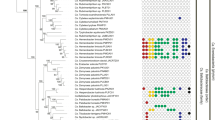Abstract
A new phototrophic bacterium was isolated from Jordanian and Kenyan alkaline salt lakes. Cells are rod shaped, 1.5 μm wide and 2–4 μm long, and motile by polar flagella. They divide by binary fission, and possess photosynthetic membranes as lamellar stacks similar to those in the other species of the genus Ectothiorhodospira and the brown colored Rhodospirillum species. The presence of bacteriochlorophyll a and carotenoids of the normal spirilloxanthin series is indicated by the absorption spectra of living cells. Under certain growth conditions the cells form gas vacuoles, may become immotile and float to the top of the culture medium. Sulfide and thiosulfate are used as photosynthetic electron donors. During the oxidation of sulfide to sulfate, elemental sulfur is formed, which is accumulated outside the cells. The organisms are strictly anaerobic, do not require vitamins, are moderately halophilic and need alkaline pH-values for growth. The new species Ectothiorhodospira vacuolata is proposed.
Similar content being viewed by others
References
Baas-Becking LGM (1925) Studies on the sulphur bacteria. Ann Bot 39:613–650
Beisenherz G, Bolzte HJ, Bücher T, Czok R, Garbade KH, Meyer-Arendt E, Pfleiderer G (1953) Diphosphofruktose-Aldolase, Phosphogylerinaldehyd-Dehydrogenase, Milchsäure-Dehydrogenase, Glycerophosphat-Dehydrogenase und Pyruvat-Kinase aus Kaninchenmuskel in einem Arbeitsgang. Z Naturforsch 8:555–577
Casse F, Bourcher C, Julliot JS, Michel M, Dénarié J (1979) Identification and characterization of large plasmids in Rhizobium meliloti using agarose gel electrophoresis. J Gen Microbiol 113:229–242
Cherni NE, Solovieva ZV, Fedorov VD, Kondratieva EN (1969) Ultrastructure of cells of two species of purple sulfur bacteria. Mikrobiologiya 38:479–484
Das B, Singh PK (1976) Isolation of gas vacuole-less mutants of the bluegreen alga Anabaenopsis raciborskii. Arch Microbiol 11:195–196
George U (1978) Geburt eines Ozeans. GEO (7):50–80
Gorlenko VM, Krasilnikova EN, Kikina OG, Tatarinova NYu (1979) The new motile purple sulphur bacteria Lamprobacter modestohalophilus nov. gen., nov. sp. with gas vacuoles. Izvest Akad Nauk SSSR, Ser Biol 5:755–767
Grant WD, Mills AA, Schofield AK (1979) An alkalophilic species of Ectothiorhodospira from a Kenyan soda lake. J Gen Microbiol 110:137–142
Imhoff JF, Trüper HG (1977) Ectothiorhodospira halochloris sp. nov., a new extremely halophilic phototrophic bacterium containing bacteriochlorophyll b. Arch Microbiol 114:115–121
Imhoff JF, Trüper HG (1981) Ectothiorhodospira abdelmalekii sp. nov., a new halophilic and alkaliphilic phototrophic bacterium. Zbl Bakt I. Abt Orig C 2:228–234
Imhoff JF, Hashwa F, Trüper HG (1978a) Isolation of extremely halophilic phototrophic bacteria from the alkaline Wadi Natrun, Egypt. Arch Hydrobiol 84:381–388
Imhoff JF, Sahl HG, Soliman GSH, Trüper HG (1978b) The Wadi Natrun: Chemical composition and microbial mass developments in alkaline brines of eutrophic desert lakes. Geomicrobiol J 1:219–234
Kondratieva EN (1956) Assimilation of organic compounds by purple bacteria in the presence of light. Mikrobiologiya 25:393–400
Pelsh AD (1936) Hydrobiology of Karabugaz. Trud Solyan Lab Akad Nauk USSR Moscow 5:49–80
Pfennig N, Trüper HG (1974) The phototrophic bacteria. In: Buchanan RE, Gibbons NE (eds) Bergey's manual of determinative bacteriology, 8th ed, Williams and Wilkins, Baltimore, pp 24–64
Puchkova NN, Gorlenko VM, Pivovarova TA (1975) A comparative ultrastructural study of vibrioid green sulfur bacteria. Mikrobiologiya 44:108–114
Raymond JC, Sistrom WR (1969) Ectothiorhodospira halophila: A new species of the genus Ectothiorhodospira. Arch Mikrobiol 69:121–126
Simon RD (1978) Halobacterium strain 5 contains a plasmid which is correlated with the presence of gas vacuoles. Nature 273:314–317
Spurr AR (1969) A low viscosity epoxy resin embedding medium for electron microscopy. J Ultrastruct Res 26:31–43
Trüper HG (1968) Ectothiorhodospira mobilis Pelsh, a photosynthetic sulfur bacterium depositing sulfur outside the cells. J Bacteriol 95:1910–1920
Trüper HG, Rogers LA (1971) Purification and properties of adenylyl sulfate reductase from the phototrophic sulfur bacterium, Thiocapsa roseopersicina. J Bacteriol 108:1112–1121
Walsby AE (1976) The buoyancy providing roles of gas vacuoles in an aerobic bacterium. Arch Microbiol 109:135–142
Walsby AE (1977) Absence of gas vesicle protein in a mutant of Anabaena flos-aquae. Arch Microbiol 114:167–170
Weidinger G, Klotz G, Goebel W (1979) A large plasmid from Halobacterium halobium carrying genetic information for gas vacuole formation. Plasmid 2:377–386
Author information
Authors and Affiliations
Rights and permissions
About this article
Cite this article
Imhoff, J.F., Tindall, B.J., Grant, W.D. et al. Ectothiorhodospira vacuolata sp. nov., a new phototrophic bacterium from soda lakes. Arch. Microbiol. 130, 238–242 (1981). https://doi.org/10.1007/BF00459526
Received:
Issue Date:
DOI: https://doi.org/10.1007/BF00459526




